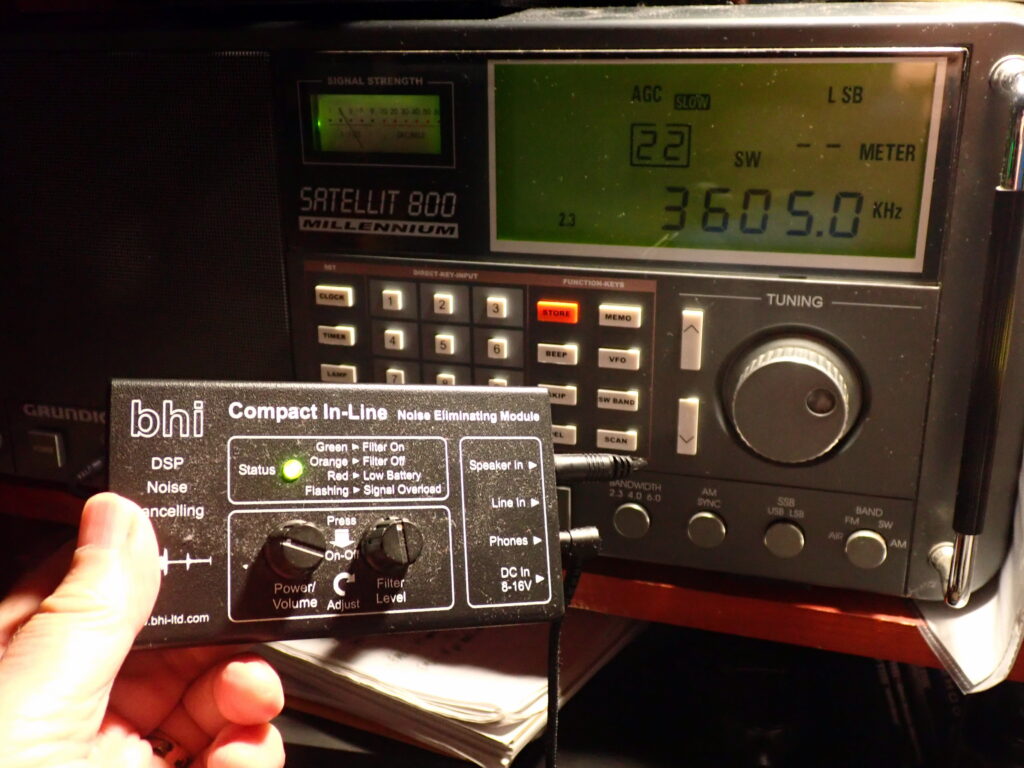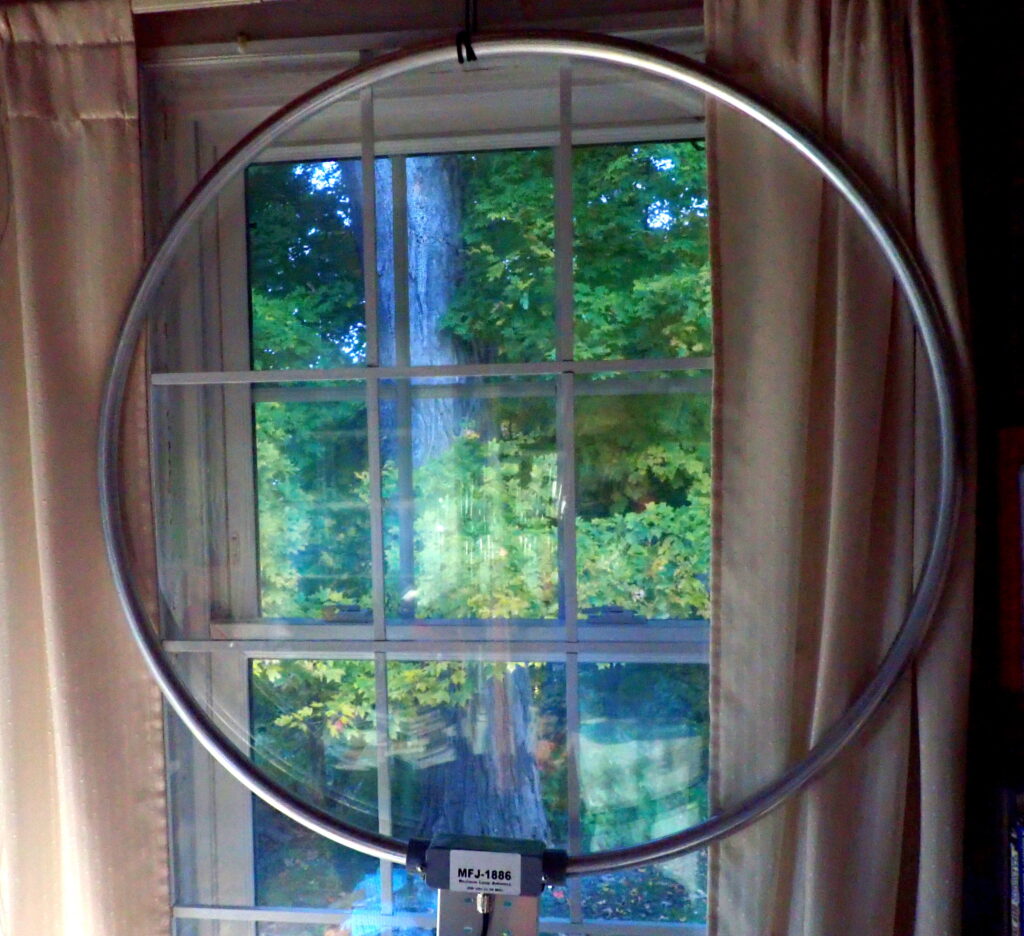By Jock Elliott, KB2GOM
Listening to the HF ham bands can be a lot of fun. All you need is a shortwave receiver capable of receiving single sideband (SSB) transmissions and a chart of the amateur bands. You can find downloadable PDF charts of the United States Amateur Radio Band Plan here or a detailed explanation of the band plan here.
Tuning around to hear what people are talking about can be enlightening. You might hear hams chatting about ham radio equipment, house repair projects, religious discussions, news and views or the state of the country, disaster response communications, or almost anything.
Recently I was tuning through the 80 meter ham band when, at 3605 LSB, I encountered a group having a conversation. I couldn’t tell if this group had a formal “Net” name, but I did get the impression that they met regularly in the early morning on that frequency, so I made a note to revisit the frequency.
Yesterday, I did so. With the horizontal room loop hooked to my Grundig Satellit 800, all I could hear was noise. The same with the whip antenna on the Satellit 800.
But when I engaged the MFJ 1886 loop antenna I could clearly hear the group talking above the noise . . . but the noise was still pretty bad. So I tried bringing the MFJ 1045C active preselector online, to no avail. The 1045C did not make the conversation easier to hear.
The noise was like a hum, not a nice gentle hum like a bumble bee flying by; no this was a nasty, raspy hum, like a circular saw trying to get purchase on a particularly tough piece of wood. Listening to the chat group on 80 meters with that noise under it would be tiring on the ears.
Soooo, what to do? Then I plugged in the BHI Compact In-line Noise Eliminating Module into the headphone socket of the Satellit 800 and then plug headphones into the BHI device.
Turning on the BHI module, I adjusted the level of noise reduction, and – tah dah! – the noise just melted away. I could hear the conversation clearly, and all that was left of the noise was the trickling water sound that is an artifact of the noise reduction algorithm.
Sometimes, the right gear just works.



The first time that I tried chokes to eliminate my own created noise on power supplies was incredible, I went between stations on the standard AM broadcast band MW, I used headphones .The noise was intense .As I wrapped the power supply lead around the ferrite choke the noise lessened dramatically. The more wraps ,the static diminished more..You can add a second choke to lessen it even further,one near the radio and the second near the a/c plug end..Computer power supplies are notorious hombre’s for noise..I wound up choking off just about everything that was plugged into a wall outlet.There is a lot of magic in them at a low expense RFI hunting can be an interesting hobby,in itself.The other solution is just run your receiver on battery power
Go for the simple culprits around you first,with good sized chokes,they are cheap,with many wraps around them, on power supplies,CFL bulb lit lamps,turn off dimmer lights etc.Run your radio on battery power an hear if that noise vacates.Connect to any sized external antenna, and see if is not the whip ant picking up indoor inerference.,if your using one and see if noise and RFI has lessened.Good Hunting,Holmes
the main issue is having the antenna inside, that alone means that the antenna sits in the middle of the “domestic electrosmog” cloud, moving the antenna outside and as far away as possible is a first step toward a real solution
Andrew,
Agreed. Working on it.
Cheers, Jock
Jack,
Very useful!
Cheers, Jock
The first time that I tried chokes to eliminate my own created noise on power supplies was incredible, I went between stations on the standard AM broadcast band MW, I used headphones .The noise was intense .As I wrapped the power supply lead around the ferrite choke the noise lessened dramatically. The more wraps ,the static diminished more..You can add a second choke to lessen it even further,one near the radio and the second near the a/c plug end..Computer power supplies are notorious hombre’s for noise..I wound up choking off just about everything that was plugged into a wall outlet.There is a lot of magic in them at a low expense RFI hunting can be an interesting hobby,in itself.The other solution is just run your receiver on battery power
https://youtu.be/ivmz4Kb0c88 Xiegu GNR-1
Wow ! Jock,brief and to the point,a magic black box I call it.There are Navy vets on every day from 7:15 Am EST till 9:00 Am every morning on 7245 Khz (LSB) 365 dat=ys a year” Shooting The Breeze”.I have the dual BHI in-line module because you can listen through speakers,have it set up on two receivers and/or listen through headphones,also,so it is a little more flexible in its use.It does need an a/c to d/c power supply or A 10-16 volt 2 amp large battery source.It is around the same price as the compact unit,like yours but also sold by DX Engineering in the States..I just found out about a new unit,also from England from Waters & Stanton called Xiegu model GNR-1 that also does noise reduction “Maybe better than the BHI units.It also comparitive in price.The GNR-1 has a few more adjustments more than the BHI modules.There is a youtube video on it being tested
Jack,
Thanks for your comments. Yup, the BHI equipment often helps a great deal.
I’ll have to check out the Xiegu model GNR-1 and also see if I can copy that Navy vets net.
Cheers, Jock
You know Jock, that is a great testimonial. No tech specs, no feature promotion, just works! This is the most encouragement I have had to try one of these! Cheers!
Thanks, Robert.
It doesn’t work in every single situation (read my original review — https://swling.com/blog/2021/11/jock-reviews-the-bhi-compact-in-line-noise-eliminating-module/ — but it works well enough and often enough to be a worthwhile addition to my shack.
Cheers, Jock
I’m going to give this unit a try; ordered it directly from BHI. My hopes aren’t high as the situation at this QTH is quite miserable from an RF noise perspective.
Bill,
I certainly hope you have good results. I was pleasantly surprised by the BHI unit (and the MFJ 1886 loop antenna for that matter) and hope to hear from you regarding your experience.
Cheers, Jock
Thanks for sharing your experiences Jock!.
The way you describe that noise reminds me of a simiklar sounding noise that suddenly popped up here a few years ago. It started just after sunset, and disappeared just after sunrise, blocking all frequencies below 5 MHz, becoming stronger as I was tuning downwards. I have a small BHI noise cancelling speaker, purchased for improving the audio output from my FT-817ND, but never thought of trying it at home since it is part of my portable QRP setup.
Instead i used a small AM pocket radio and walked around the house and garden, discovering that the noise vanished at aproximately 30 meters (100 feet) from the house. Finally I discovered that the noise was strongest at the corner of the house just below a lamp. After a little head scratching I went inside and turned the outside lights off. The noise dissappeared!
Three weeks before this, one of the bulbs in my two ouside lamps went dead, and when bying a new one, I decided to get a couple of LED bulbs of the kind that turns on and off automaticly, controlled by a built-in solar cell. Bying two new LED bulbs whithout the solar cells got rid of the noise. The only “smart” LED bulbs on the market at that time was made by OSRAM. Now I notice that there are several other brands, so I wonder if other radio enthusiasts have found a brand that makes no radio noise.
Egil,
I don’t know of noise-free LED bulbs, but good on you for chasing the noise source.
Many years ago, I wrote a piece for QST magazine . . . The Strange Case of the Clockwork Noise.
My neighbor (also a ham, like me) and I noticed a horrendous noise blanking out an enormous chunk of the spectrum every 12 seconds or so (if I recall correctly). The neighbor and I chased it (I was Watson to his Holmes), and eventually found that it was a doorbell transformer belonging to a little old lady in a house a couple of streets away. The transformer was melting some internal insulation, shorting out (making terrible noise), then cooling down, stopping down, and starting the process all over again. My neighbor replaced her doorbell transformer, and piece returned to the airwaves.
Short version: chasing noise can be a serious challenge!
Cheers, Jock